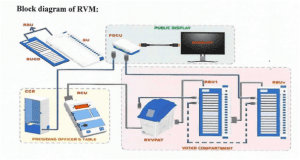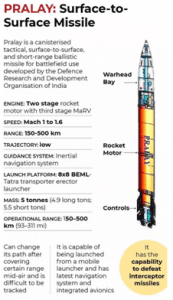POLITY AND GOVERNANCE
1. REMOTE ELECTRONIC VOTING MACHINE (RVM)
TAGS: PRELIMS PERSPECTIVE- GS-II-POLITY AND GOVERNANCE
THE CONTEXT: Recently, the Election Commission of India (ECI) has developed a prototype for the Remote Electronic Voting Machine (RVM) aimed to facilitate voting for domestic migrants across India.
THE EXPLANATION:
- The prototype of the RVM will be demonstrated to political parties on January 16th, and if it is successful, it will allow domestic migrants to vote without having to travel back to their hometowns. The RVM will be a stand-alone system, not connected to the internet, and based on existing electronic voting machines. The goal of the RVM is to increase voter participation and make it easier for domestic migrants to participate in elections.
What are RVMs?
- The RVM is a multi-constituency electronic voting machine that can handle up to 72 constituencies from a single remote polling booth. It is based on the time-tested M3 (Mark 3) EVMs and will be used to enable voting at remote polling stations for domestic migrants.
- The ECI has invited all eight recognized national and 57 state political parties to a demonstration of the RVM on January 16th, and has also solicited written views from these parties by January 31st on various related issues, including changes needed in legislation and administrative procedures.

Challenges
- There are several challenges and considerations that must be addressed in order to successfully implement the RVM system.
- These include defining domestic migrants, enumerating remote voters, and ensuring the secrecy of voting and the presence of polling agents for voter identification.
- The Representation of the People Act, 1950 and 1951, The Conduct of Election Rules, 1961, and The Registration of Electors Rules, 1960 will also need to be amended to introduce remote voting.
- Other considerations include the method of remote voting, the familiarity of voters with the RVM technology, and the counting and transmission of votes cast at remote polling stations.
Why do we need RVMs?
- There is no central database available for migration within India, but analysis of available data suggests that work, marriage, and education are major factors in domestic migration. “Out-migration” is more common among the rural population, and around 85% of internal migration is within states.
- The ECI has developed the RVM system in order to make it easier for domestic migrants to participate in elections, as many are reluctant to register to vote at their place of work due to frequently changing residences, a lack of social and emotional connections with their area of migration, or a desire to keep their name on the electoral roll of their home or native constituency.
Connect the dots:
- What is Proxy voting?
ENVIRONMENT AND ECOLOGY
2. PALEONTOLOGISTS FIND FOSSIL OF 119-MILLION-YEAR-OLD BEAKED BIRD
TAGS: PRELIMS PERSPECTIVE- ENVIRONMENT AND ECOLOGY
THE CONTEXT: Recently, a new species of confuciusornithid bird being named Confuciusornis shifan has been identified from a nearly complete skeleton found in northeastern China.
THE EXPLANATION:
- Confuciusornis shifan lived in what is now China during the Early Cretaceous epoch, some 119 million years ago.
- The new species belonged to Confuciusornis, a genus of extinct crow-sized beaked birds in the family Confuciusornithidae.
- Confuciusornis shifan weighed less than 200 grams and was smaller than most other confuciusornithid species.
- “Confuciusornithidae is a clade of Early Cretaceous pygostylian birds known from the Jehol Biota of East Asia, and represents the earliest known toothless, beaked birds”.
- “Five genera and eleven species, recovered from the Dabeigou, Yixian and Jiufotang formations, have been described and assigned to this family, though the validity of some species is questionable.”
- “They are represented by thousands of exceptionally preserved specimens that collectively provide rich information on confuciusornithid morphology, taxonomy, flight ability, growth, diet, and ecology.”
Connect the dots:
- What is Cretaceous epoch?
3. T.N. GOVERNMENT SETS UP NILGIRI TAHR CONSERVATION PROJECT
TAGS: PRELIMS PERSPECTIVE- ENVIRONMENT AND ECOLOGY
THE CONTEXT: Recently, the Tamil Nadu government launched an initiative for the conservation of the Nilgiri Tahr, the State animal, at a cost of ₹25.14 crore.
THE EXPLANATION:
- Under The Nilgiri Tahr project, the government plans to develop a better understanding of the Nilgiri Tahr population through surveys and radio telemetry studies; reintroduce the Tahrs to their historical habitat; address proximate threats; and increase public awareness of the species. The project is to be implemented from 2022 to 2027.

- According to the order, there are multiple references to the Nilgiri Tahr in Tamil Sangam literature dating back to 2,000 years. The late Mesolithic (10,000-4,000 BC) paintings highlight the significance of the Tahr in folklore, culture and life. It was designated as the State animal in recognition of its ecological and cultural significance.
- The Wildlife (Protection) Act of 1972 under Schedule 1 protects this ungulate species, which is also listed as endangered by the International Union for Conservation of Nature and the sole Caprinae species found in the tropical mountains of southern India. The animal inhabits meadows with steep cliffs at elevations between 300 metres and 2,600 metre above sea level. It is estimated that there are 3,122 Nilgiri Tahrs in the wild. Historically, the Nilgiri Tahr was known to inhabit a large portion of the Western Ghats. But today it remains restricted to a few scattered patches in Tamil Nadu and Kerala. It has become locally extinct in around 14% of its traditional shola forest-grassland habitat.
Value Addition:
About Mukurthi National Park:
- The park was previously known as Nilgiri Tahr National Park.
- It was declared as a National Park in the year of 1990. The total area of the park is about 78.46 Km2. The park is characterized by montane grasslands and shrublands interspersed with sholas in a high altitude area of high rainfall, near-freezing temperatures and high winds.
- The park is a part of Nilgiri Biosphere Reserve, India’s first International Biosphere Reserve. As part of the Western Ghats, it is a UNESCO World Heritage Site since 1 July 2012. The Park is sandwiched between the Mudumalai National Park and the Silent Valley National park.

4. PRALAY MISSILE
TAGS: PRELIMS PERSPECTIVE- SCIENCE & TECHNOLOGY
THE CONTEXT: In a major boost to the striking capabilities of the Indian armed forces, the defense ministry has recently cleared a proposal to purchase 120 Pralay missiles for the Indian Air Force and Army.
THE EXPLANATION:
- Pralay is an indigenous short-range ballistic surface-to-surface missile. The missile will be India’s first tactical quasi-ballistic missile and will give the armed forces the capability to hit enemy positions and key installations in actual battlefield areas.
- Developed by: The solid-fuel, battlefield missile developed by the Defence Research Development Organisation (DRDO) is based on Prithvi Defence Vehicle from the Indian ballistic missile programme.
- Features:
- Pralay’ is powered with a solid propellant rocket motor and other new technologies. The missile guidance system includes state-of-the-art navigation and integrated avionics, according to the DRDO.
- The advanced missile has been developed in a way to be able to defeat interceptor missiles. It has the ability to change its path after covering a certain range mid-air.
- It is capable of carrying a conventional warhead of about 350 kg to 700 kg, which gives it a deadly punitive capability.
- Range: The canisterised Pralay missile, has a range of 150-500 kilometres.
- Ballistic missiles: They are initially powered by a rocket or series of rockets in stages, but then follow an unpowered trajectory that arches upwards before descending to reach its intended target at high speed. Unlike intercontinental ballistic missiles that exit the Earth’s atmosphere, short-range ballistic missiles stay within it.
REVISION SERIES
5. PRADHAN MANTRI GARIB KALYAN ANNA YOJANA (PMGKAY)
TAGS: PRELIMS PERSPECTIVE- GS-II-GOVERNMENT INTERVENTIONS
THE CONTEXT:Recently, the the Union government announced that it would discontinue the Pradhan Mantri Garib Kalyan Anna Yojana (PMGKAY) from January 1, 2023.
THE EXPLANATION:
- In the wake of economic disruptions caused by the unprecedented outbreak of COVID-19 in the country, the Government in March 2020 had announced the distribution of additional free-of-cost food grains (Rice/Wheat) to about 80 Crore National Food Security Act (NFSA) beneficiaries at the scale of 5 Kg per person per month under the PM Garib Kalyan Anna Yojana (PM-GKAY).
- Phase-I and Phase-II of this scheme were operational from April to June 2020 and July to November 2020 respectively. Phase II of the scheme was operational from May to June 2021. Phase IV of the scheme is currently operational for July-November 2021 months.
- Pradhan Mantri Garib Kalyan Anna Yojana (PM-GKAY) under the Ministry of Finance is a scheme as part of Atmanirbhar Bharat to supply free food grains to migrants and the poor.
Eligibility
- Families belonging to the Below Poverty Line – Antyodaya Anna Yojana (AAY) and Priority Households (PHH) categories will be eligible for the scheme.
- PHH are to be identified by State Governments/Union Territory Administrations as per criteria evolved by them. AAY families are to be identified by States/UTs as per the criteria prescribed by the Central Government:
- Households headed by widows or terminally ill persons, or disabled persons or persons aged 60 years or more with no assured means of subsistence or societal support.
- All primitive tribal households.
- Landless agriculture labourers, marginal farmers, rural artisans/craftsmen such as potters, tanners, weavers, blacksmiths, carpenters, slum dwellers, and persons earning their livelihood on daily basis in the informal sector like porters, coolies, rickshaw pullers, hand cart pullers, fruit and flower sellers, snake charmers, rag pickers, cobblers, destitute and other similar categories in both rural and urban areas.
- All eligible Below Poverty Line families of HIV positive persons.
Connect the dots:
- National Food Security Act (NFSA) 2013


